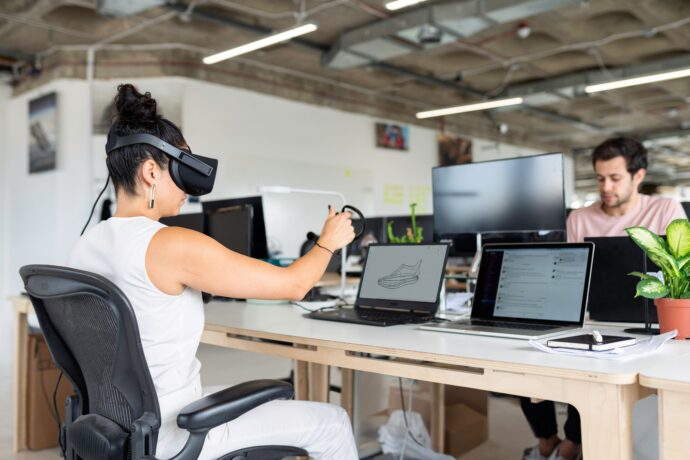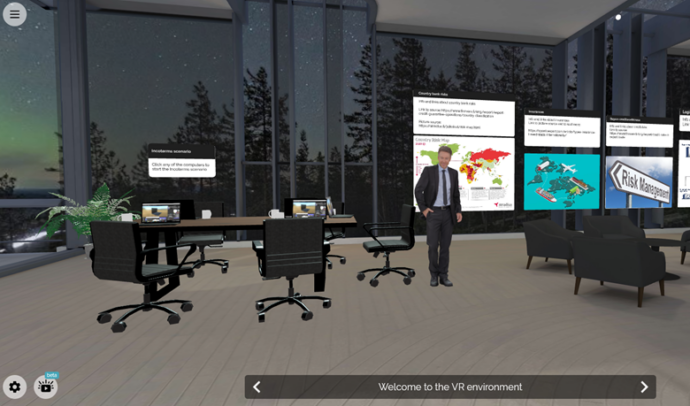In the spring of 2022, two business student teams from Laurea University of Applied Sciences were assigned to develop training simulators in virtual reality for small and medium-sized enterprises (SMEs) by VIVA research, development and innovation project (RDI). The aim of the simulators was to allow companies to practice international trade agreement negotiations and to train their personnel in sustainable supply chain management. The goal was also to design fun and motivating simulators that inspire and spark interest towards continuous learning of international trade. The development process was an agile experiment based on iterations, testing and continuous improvement. In the co-creation process participated students, instructors, experts, and companies.
 Picture: Thisisengineering/ Pexels
Picture: Thisisengineering/ Pexels
The purpose of the VIVA – Virtual Technologies Boost SME Exports project, funded by the Helsinki–Uusimaa Regional Council, is to provide SMEs with a new way to simulate and practice export trade interactions. The project encounters export trade, modern technologies and continuous learning. Modern technologies refer to Augmented Reality (AR) and Virtual Reality (VR). (Heiskanen & Kuhmonen 2021.)
The VIVA project combines the simulation expertise acquired during the development work of Laurea UAS’ simulation hospital and the simulation teaching of nurses with the gamification expertise gained from the collaborative serious game design and development projects, for example TradeAway mobile game. It applies previously acquired know-how for the co-creation of an open, multidisciplinary learning environment for SMEs for practicing export skills. (Heiskanen et al 2013; Rosenberg et al 2013; Pöyry-Lassila et al 2017; Anttila et al 2019.)
First, we present the learning objectives, implementation and outcomes of the two co-creation experiments. Second, we reflect on our findings on the challenges of engaging enterprises in co-development and continuous learning, and on the use of the virtual reality for SME learning.
Agile experiments based on continuous improvement
Our approach was to integrate the scenario-based learning and game design-based learning within the service design framework out of a willingness to understand the needs of end-users and to see them as active co-creators. Service design has been introduced as a methodology and a process for enabling customer-centered development and co-creation. (e.g., Stickdorn et al., 2018; Yu & Sangiorgi, 2018.)
The learning objectives of the two development processes and the simulators themselves were focused on 1. how to educate SMEs to choose the right payment and delivery terms when negotiating the trade agreement with the foreign buyer, 2. how SMEs can educate their personnel about the sustainability in the supply chain and 3. how to utilize virtual reality in continuous learning.
Both training simulator development processes consisted of three cycles: Firstly, the students learned how to create scenarios by participating in the lecture about simulation pedagogy and the training sessions “AR and VR in business”. They also watched the training videos and practiced the use of the WondaVR tool. Additionally, they were given an introductory lecture on international trade by the VIVA project’s senior advisor. Secondly, brainstorming and prototyping sessions including several sprints were organized on a weekly basis and guided by the instructor. The goal of the prototyping was to give the design ideas a concrete form and to enable communicating and testing the ideas (Blomkvist & Holmlid, 2010). Thirdly, three testing and learning workshops were implemented for the feedback and for continuous improvement.
 Figure 1: International trade agreement negotiation scenario in WondaVR (Viva project 2022).
Figure 1: International trade agreement negotiation scenario in WondaVR (Viva project 2022).
The developed simulators will be an essential part of the final outcome of the VIVA project, an open, multidisciplinary continuous learning environment for SMEs for practicing export skills. The simulators were demoed by the students to the SMEs in the VIVA project’s “Power up green export skills webinar” in May 2022. The experiments were presented also at Pedaforum 2022 — Higher Education Pedagogy seminar in August 2022, where the presentation initiated lively discussions about the benefits of the utilization of modern technologies in business and learning, and about the security of virtual reality exploitation.
Lack of time, motivation and a growth mindset are key obstacles to skills development in SMEs
Design research was conducted during the development work. It is a method that combines development and research in a cyclical process involving theoretical and experimental phases. The aim of the methodology is to develop teaching in real situations systematically, flexibly and iteratively. Design research may include concrete design and development of pedagogical models, teaching methods, learning materials and learning environments. Design-based research is well suited for studying learning in real-life context. (Barab et al, 2006; Collins et al, 2004.)
The research question was: In the context of export industry, how to facilitate 1. SMEs’ learning of complex topics of the international trade negotiations and 2. SMEs’ training of personnel in the sustainability of the supply chain by utilizing the principles of design thinking, service design, game-based learning and scenario-based learning?
We approached our research question by asking 1. how companies better educate themselves promoting continuous learning and 2. whether virtual reality simulators are a meaningful way to learn for companies. Regarding the learning in virtual reality, our findings support the results of the previous studies showing that one of the advantages of the usage of the virtual reality in the continuous learning of the companies is that it enables hands-on learning and practicing scenarios that simulate real-life situations. The virtual reality also provides a stimulating environment to practice and rehearse different skills, in our case export skills, and enhances risk-free making of mistakes. (Kuhmonen & Heiskanen 2022.)
According to our preliminary observations, it can be stated that it is difficult to motivate exporting SMEs to participate in the co-creation processes and peer-learning opportunities. As obstacles, companies have mentioned, among other things, the lack of time and other resources caused by the COVID19 pandemic and the Ukrainian war, and the need to focus on putting out business fires.
The representatives of SMEs state that figuring out the benefits offered by virtual reality for your own international business is difficult. And the adoption of modern technologies is perceived to take too much time in relation to the imagined benefits, despite of the fact that the WondaVR, utilized in the VIVA project is claimed to be an easy-to-build and easy-to-use tool.
Our findings indicate also that it requires a change of mindset from exporting SMEs to take responsibility for their own sustainable learning and start systematically investing in the development of export skills and the strategy-driven continuous learning.
All the mentioned obstacles need to be taken into consideration when designing new simulators. In the future, it is planned to develop “Pre-export homework and acid test” and “Circular economy” simulators. More interaction with SMEs is needed to find out what other barriers might exist to not taking up learning opportunities. The aim of further development work is to find new ways to strengthen the involvement of companies in the development work of simulators and in the deployment of the simulators developed. More research will be conducted on how to facilitate and design exporting SMEs’ learning.
References:
- Anttila, A., Juuti, K., Laamanen, K., Vivolin, M., Heino, P., Kuhmonen, A., Kyrö, J.& Saarikoski, V. 2019. Tuurillako vientikauppaa käydään? Toimintatutkimus pk-yrityksille riskienhallinnasta ja rahoitusosaamisesta TradeAway-mobiilipelin avulla. Laurea Julkaisut 127.
- Barab, S. 2006. Design‐Based Research. A methodological toolkit for the learning scientist, In: R. K. Sawyer (ed.) The Cambridge Handbook of the Learning Sciences, 153–169. Cambridge University Press, New York.
- Collins, A., Joseph, D. & Bielaczyc, K. 2004. Design Research: Theoretical and Methodological Issues, The Journal Of The Learning Sciences, Vol 13, No. 1, pp 15‐42.
- Heiskanen, M. & Kuhmonen, A. 2021. Tietoja. https://vivaboost.fi/tietoja/. Retrieved: 26.10.2022.
- Heiskanen, M., Kämäräinen, J. & Jokela, J. 2013. Achieving a more developed simulation pedagogy in nursing through student feedback. Interdisciplinary Studies Journal – Vol 3, Number 2, 2013 © Laurea University of Applied Sciences. https://www.academia.edu/48066488/ISJ_Vol_3_No_2. Retrieved: 26.10.2022.
- Kuhmonen, A. & Heiskanen, M. Virtual Reality in Continuous Learning. Laurea Journal. 2022. https://journal.laurea.fi/virtual-reality-in-continuous-learning/#0f9b3a12. Retrieved: 26.10.2022.
- Pöyry‐Lassila, P., Kuhmonen, A. & Marjanen, P. 2017. TradeAway: Collaborative Game Design and Development as a Learning Environment. Academic Conferences International Limited, Reading, 10, pp. 546‐553. https://www.theseus.fi/handle/10024/140156. Retrieved: 26.10.2022.
- Rosenberg, P., Silvennoinen, M., Mattila, M-M., Jokela, J. & Ranta, I. (toim.) 2013. Simulaatio-oppiminen terveydenhuollossa. Fioca, Helsinki.
- Stickdorn, M., Adam, L., Hormess, M.E. & Schneider, J. 2018. This is service design doing: applying service design thinking in the real world: a practitioner’s handbook. Sebastopol, CA: O’Reilly Media, Inc.
- Yu, E. & Sangiorgi, D. 2018. Service Design as an Approach to Implement the Value Co-creation Perspective in New Service Development. Journal of Service Research, 21(1) pp. 40-58.